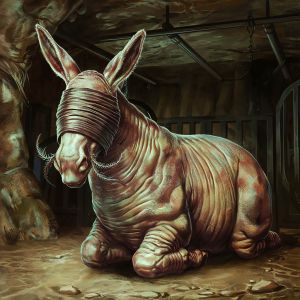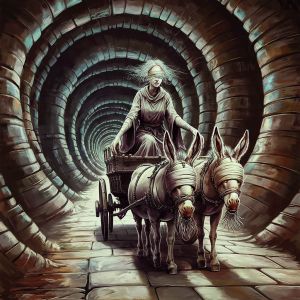Thramak: Difference between revisions
No edit summary |
No edit summary |
||
| (4 intermediate revisions by the same user not shown) | |||
| Line 8: | Line 8: | ||
{{Beastiary Sections | {{Beastiary Sections | ||
|Introduction=The '''Thramak''' is a subterranean beast of burden domesticated by the [[Minthari]] of [[Terasil]]. Bred for endurance and sensory acuity in the underground tunnel networks of the [[Minthal Range]], the Thramak plays a vital role in Minthari transport, mining, and agriculture. | |Introduction=The '''Thramak''' is a subterranean beast of burden domesticated by the [[Minthari]] of [[Terasil]]. Bred for endurance and sensory acuity in the underground tunnel networks of the [[Minthal Range]], the Thramak plays a vital role in Minthari transport, mining, and agriculture. | ||
|Origin and Nature=The Thramak evolved from donkeys brought by | |Origin and Nature=The Thramak evolved from donkeys brought by humans into the depths of [[Minthal]] during the great migration. Like the humans themselves, the donkeys were quickly influenced by the strong presence of [[Desame]] imbuing in them a strong drive but eventually depriving them of their site ability to exist above ground. | ||
|Biology and Physical Traits=Thramaks are compact, quadrupedal mammals roughly 4.5 feet at the shoulder and 6 feet in body length. Their thick, rubbery hide ranges in tone from dark basalt to umber, providing protection from rough tunnel walls and geothermal heat. They are entirely blind; their eyes have atrophied into calloused ridges. Instead, they navigate via a combination of whiskers and hooves that can sense subtle vibrations. | |Biology and Physical Traits=Thramaks are compact, quadrupedal mammals roughly 4.5 feet at the shoulder and 6 feet in body length. Their thick, rubbery hide ranges in tone from dark basalt to umber, providing protection from rough tunnel walls and geothermal heat. They are entirely blind; their eyes have atrophied into calloused ridges. Instead, they navigate via a combination of whiskers and hooves that can sense subtle vibrations. | ||
Thramaks possess enlarged lungs and a slow, efficient metabolism that allows them to work for long periods with minimal food and water. Their diet consists primarily of cultivated cave fungi and mineral-rich lichen. | Thramaks possess enlarged lungs and a slow, efficient metabolism that allows them to work for long periods with minimal food and water. Their diet consists primarily of cultivated cave fungi and mineral-rich lichen. | ||
[[File:Thramak_-_Drawing_02.jpg|thumb|A Thramak pulling a wagon]] | |||
|Behavior=Thramaks are calm, herd-oriented animals. They bond closely to their handlers through low-frequency vocalizations and are trained using rhythmic tapping and tonal cues. Their common behaviors include: | |Behavior=Thramaks are calm, herd-oriented animals. They bond closely to their handlers through low-frequency vocalizations and are trained using rhythmic tapping and tonal cues. Their common behaviors include: | ||
| Line 19: | Line 20: | ||
|Cultural Significance=To the Minthari, Thramaks are more than beasts of burden—they are loyal companions and living symbols of subterranean resilience. Harming a Thramak unnecessarily is a serious taboo, and tales abound of Thramaks rescuing lost miners or returning with critical supplies after collapse | |Cultural Significance=To the Minthari, Thramaks are more than beasts of burden—they are loyal companions and living symbols of subterranean resilience. Harming a Thramak unnecessarily is a serious taboo, and tales abound of Thramaks rescuing lost miners or returning with critical supplies after collapse | ||
|Uses=* Pulling ore carts and water sledges. | |Uses=* Pulling ore carts and water sledges. | ||
* | * Transporting goods through the Grand Tunnels. | ||
* Powering small-scale lifting mechanisms in vertical shafts. | * Powering small-scale lifting mechanisms in vertical shafts. | ||
}} | }} | ||
[[Category:Minth]][[Category:Minthari]] | |||
Latest revision as of 02:00, 11 April 2025
| Thramak | |
|---|---|
| Image |  |
| Classification | Beast of Burden |
| Average Height | 4.5 Feet |
| Average Lifespan | 30-40 years |
Introduction
The Thramak is a subterranean beast of burden domesticated by the Minthari of Terasil. Bred for endurance and sensory acuity in the underground tunnel networks of the Minthal Range, the Thramak plays a vital role in Minthari transport, mining, and agriculture.
Origin and Nature
The Thramak evolved from donkeys brought by humans into the depths of Minthal during the great migration. Like the humans themselves, the donkeys were quickly influenced by the strong presence of Desame imbuing in them a strong drive but eventually depriving them of their site ability to exist above ground.
Biology and Physical Traits
Thramaks are compact, quadrupedal mammals roughly 4.5 feet at the shoulder and 6 feet in body length. Their thick, rubbery hide ranges in tone from dark basalt to umber, providing protection from rough tunnel walls and geothermal heat. They are entirely blind; their eyes have atrophied into calloused ridges. Instead, they navigate via a combination of whiskers and hooves that can sense subtle vibrations.
Thramaks possess enlarged lungs and a slow, efficient metabolism that allows them to work for long periods with minimal food and water. Their diet consists primarily of cultivated cave fungi and mineral-rich lichen.

Behavior
Thramaks are calm, herd-oriented animals. They bond closely to their handlers through low-frequency vocalizations and are trained using rhythmic tapping and tonal cues. Their common behaviors include:
- Standing sleep, often braced against stone walls.
- Infrasonic bellows of contentment.
- Rumbling or stamping when agitated or alerting others to danger.
Cultural Significance
To the Minthari, Thramaks are more than beasts of burden—they are loyal companions and living symbols of subterranean resilience. Harming a Thramak unnecessarily is a serious taboo, and tales abound of Thramaks rescuing lost miners or returning with critical supplies after collapse
Uses
- Pulling ore carts and water sledges.
- Transporting goods through the Grand Tunnels.
- Powering small-scale lifting mechanisms in vertical shafts.